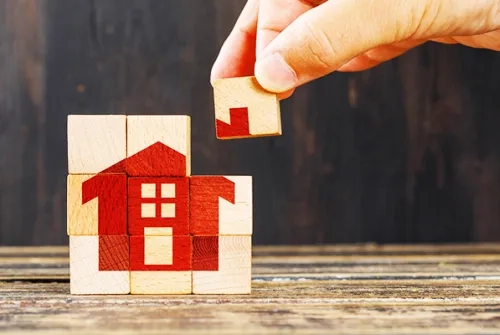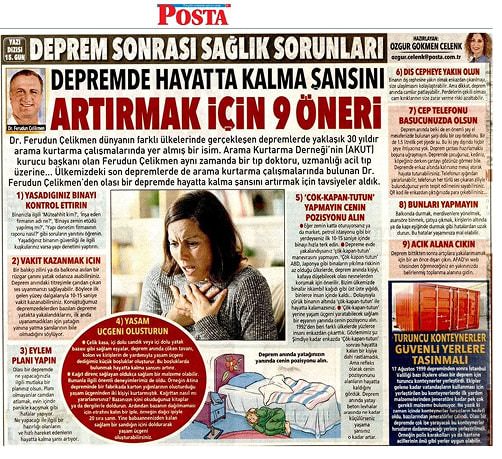Alo Yeditepe
9 Ways to Increase Your Chances of Surviving an Earthquake!
Dr. Ferudun Çelikmen has been involved in search and rescue efforts for nearly 30 years in earthquakes in different countries of the world. Ferudun Çelikmen, the founding president of the Search and Rescue Association (AKUT), is also a medical doctor, specializing in emergency medicine... Participating in search and rescue efforts in the recent earthquakes in our country, Yeditepe University Hospitals Emergency Medicine Specialist Dr. Ferudun Çelikmen has suggestions about survival in a possible earthquake.
Have an Inspection of the Building You Live In
The questions such as, 'Who is the contractor?‘, 'What is the name of the company that built it?', 'Has a ground study been carried out on the building?', ‘How is the report of the building audit company?' must be asked. If you have doubts about the safety of the building you live in, have a building inspection.
In order to Save time...
You can hang a fishing bell or a wind chime hanging on the balcony in your bedroom. The vibration of the earthquake and the sound of the bell can wake you up. Thus, you can save 10-15 seconds with the first coming earthquake waves. Some of the earthquake victims we talked to say that they were caught in the bed and that they did not even have a chance to sleep next to the bed because they could not wake up at the first moment.
Make an Action Plan
Make sure you have a plan for what to do in the event of an earthquake. Those who do not have a plan make mistakes such as jumping out the window, and running away from the house in panic. Those who are prepared for what to do and those who move quickly have an increased chance of survival.
Create a Life Triangle
At the first shake, create a triangle of life by taking a fetal position next to a solid object such as a steel case, a crate filled with a crate, or a bed base filled with a crate. Keep your head between your hands. Wait until the shake is over. Paper can be a pretty solid material that provides resistance. We have also had important experiences with this. For example, we saved two people from a life triangle formed by piles of cardboard in a factory during the Athens earthquake. How do you use paper? Fill some of them with books or magazines you have read. Then wrap the base around 20 rows with a thick rope, for example, a climber rope, so that it does not disintegrate. Again, you can create a triangle of life by filling in a solid chest left by your grandmother.
Do Not ‘Collapse -Trap-Hold’, Get Fetal Position
If you are sitting on the ground floor or in a place such as a grocery store or a petrol station, quickly leave the building within the first 10-15 seconds. In countries where the risk of collapse of buildings is low, such as the US and Japan, it is recommended to protect the person from possible objects that may fall on the head in the event of an earthquake. In our country, buildings collapsed like playing cards, and thousands of people were trapped... So, you cannot survive with a ‘collapse-trap-hold’ under a rotten building.
”Take a fetal position next to a solid object that can create a triangle of life instead of ’collapse-close-hold'. Since 1992, we have pulled hundreds of people out of the wreckage in different countries. Our observation: So far, we have not found a single survivor of the ’Crash-close-hold' in the wreckage. But reflexively, we found that those who took the fetal position survived. The smaller you are among the horizontal concrete slabs during an earthquake, the better your chances of survival.
 Stay Close to the Exterior
Stay Close to the Exterior
Being close to the exterior of the building can make it easier to get out of the wreckage and reach you. But beware, in the event of an earthquake, the windows may burst. The fact that the curtains are drawn may reduce the risk of glass fractures harming you.
Keep Your Mobile Phone With You
Perhaps the most important thing during an earthquake is a mobile phone with a full charge within your reach. Plus, 1.5 liters of water in a pet bottle. You do not need anything but these two things. Do not bother packing an earthquake bag. If you are under debris in the earthquake, you can hang on to life by texting. You can benefit from the light of the phone and count the detection of your location with all kinds of sounding bells of the phone. You can withdraw money when you get out of the wreckage with a QR code...
Do Not Do These
Avoid mistakes such as standing on the balcony, heading for the stairs, getting on the elevator, going up to the roof, standing under the beams, or on the door sill. These mistakes can cost you your life.
Go Outdoors
After the earthquake is over, go out as soon as possible to avoid catching the aftershocks. Go to the designated assembly area nearest you, which you will learn from AFAD's website.
Orange Containers Must Be Moved to Safe Places
After the earthquake of August 17, 1999, the Governorship of Istanbul placed orange containers in some districts for a possible earthquake. These containers, which are placed for citizens to use until the teams arrive, contain many necessary materials from first aid supplies to the generator. Unfortunately, over time, the containers became the target of thieves, some of them stealing generators. These containers, which will be very useful in a possible earthquake, should be placed in places where thieves will not be haunted. For instance, places such as police stations or in front of hospital emergency rooms may be appropriate.

 Stay Close to the Exterior
Stay Close to the Exterior